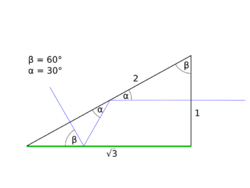Bauernfeind prism
A Bauernfeind prism is a type of reflecting prism used to deviate a beam of light by 45° to 60°, depending on its construction, while neither flipping nor rotating the image.[1] It is named for its inventor, the German expert of geodesy Karl Maximilian von Bauernfeind.[2]
The beam is reflected twice in the prism, with one reflection happening at less than the critical angle. Therefore, the prism requires a reflective coating for this surface to be usable in practice.
A Bauernfeind prism with 45° beam deviation is also known as a half-penta prism or semipentaprism.[3][4] A Bauernfeind prism is used together with a Schmidt roof prism to form a Schmidt–Pechan prism.
Applications
The Bauernfeind prism is commonly used in microscope tubes and in geodesy to deviate the path to the eyepiece in order make the device more ergonomic.[5]
More recent applications are glasses that deflect the viewing angle either downwards (for relaxed reading or watching TV[6]), or upwards (as in belay glasses for watching a climber while belaying).
References
- ↑ Hanno Schmidt (26 May 2009). "6-PRISMA". http://www.dorotek.de/cms/upload/pdf/optik/deutsch/6-PRISMA.pdf. Retrieved 2015-03-22.
- ↑ Techniklexikon.net. "Bauernfeind-Prisma - Techniklexikon". techniklexikon.net. http://www.techniklexikon.net/d/bauernfeind-prisma/bauernfeind-prisma.htm. Retrieved 2015-03-22.
- ↑ "www.edmundoptics.com/optics/prisms/image-rotation-prisms/half-penta-prisms/3249". edmundoptics.com. http://www.edmundoptics.com/optics/prisms/image-rotation-prisms/half-penta-prisms/3249. Retrieved 2015-03-22.
- ↑ "VOB Lumex -- Prisms". http://www.tecplusplus.de/ManualLu/prisms.htm. Retrieved 2015-03-22.
- ↑ Optik: Physikalisch-technische Grundlagen und Anwendungen, p. 475, at Google Books (in German)
- ↑ "Prismenbrillen, Liegebrillen, Teleskopspiegel - REHADAT-Hilfsmittel". rehadat-hilfsmittel.de. http://www.rehadat-hilfsmittel.de/de/kommunikation-information/sehhilfen/liegebrillen/index.html. Retrieved 2015-03-22.


